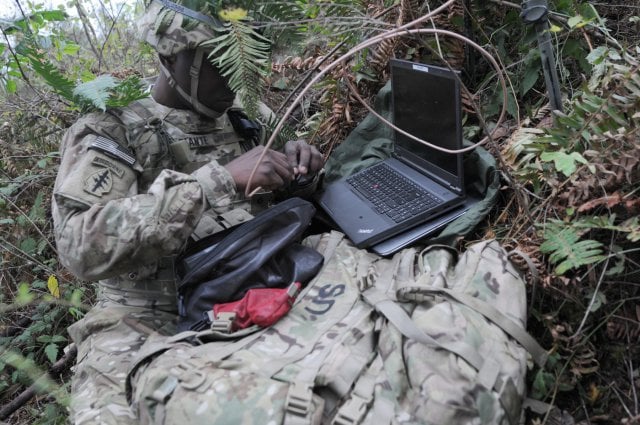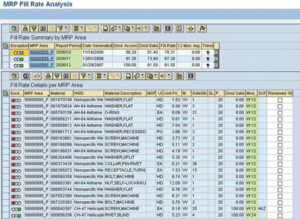
A soldier from the Army’s offensive cyber brigade during an exercise at Fort Lewis, Washington.
WASHINGTON: Warfighters can’t wait passively for some Pentagon mega-program to deliver the AI-driven command system of the future, the director of the Joint Artificial Intelligence Center says in an exclusive interview. Commanders and officials across the Defense Department must be active, informed consumers of AI, Lt. Gen. Mike Groen says, because their specific professional expertise and their organizations’ unique data are essential to customizing AI algorithms to their different missions.

Lt. Gen. Michael Groen
“There’s still a lot of folks who believe that, ‘oh, somebody’s going to bring a big box of AI and set it on my desk,’” Groen believes. “But AI is a general-purpose technology. It’s not really useful by itself. It’s useful in how it transforms everything that it’s applied to… kind of like electricity.”
“This is not some black box,” he emphasizes. “This is about your insight into the battlefield. This is about your processes for generating that insight. This is about your ability to quickly game potential outcomes and be able to pick what’s best.”
Ultimately, it comes down a basic question: “How do we want to fight?” Groen says. “That’s not a question for IT people. ‘How do we want to fight’ is a question for warfighters.”
[Click to read Lt. Gen. Groen’s exclusive op-ed for Breaking Defense: Uncle Sam Needs AI, ASAP]
Building JADC2 From The Bottom Up
Linking all the services – across land, sea, air, space, and cyberspace – into an AI-driven system of Joint All Domain Command & Control (aka JADC2) may seem like a top-down, technology-driven effort. But it’s not, Groen argued: A lot of JADC2 has to be built from the bottom up, based on the needs and expertise of military professionals.
“JADC2 is not an IT system,” he says. “It is a warfighting system. I think it’s misunderstood in a lot of ways. Historically, you would have a large defense program, and you would spend years refining the requirements, and you would gather big, big bags of money, and then you would go to a defense contractor and spend more years building, testing, and then finally fielding something years and years later.”
“JADC2 is not that,” he says. “JADC2 is not a program at all. JADC2 is a construct where we start bringing capabilities and implementing them now, and then start stitching them together[:] the Army with Project Convergence, the Air Force with ABMS, the Navy with Project Overmatch.”
“Every service develops their own AI….Every defense agency will develop its own unique AIs,” he emphasizes. While the Joint AI Center is developing some cutting-edge artificial intelligence in-house, “we’re not big enough to build all the AIs for everybody in the department.”
Instead, he says, the JAIC can provide the technical expertise to help organizations across the Defense Department grow their own custom AIs, from contracting vehicles to a software development environment called the Joint Common Foundation.

Joint Artificial Intelligence Center graphic
But AI expertise isn’t the only kind you need, Groen emphasizes. If you want AI to help you spot targets in drone video and satellite imagery, then you need experts in intelligence analysis to explain how human beings do that today. If you want AI to take those targets and pick what aircraft or artillery unit is best suited to strike them, you need an experts in fire support. If you want AI to schedule mid-air refueling for those aircraft or ammo resupply runs for that artillery, you need experts in logistics.
“You’re… getting warfighters to the table,” Groen says. “Now you bring a data scientist into help them create a flow chart and help them figure out what that data flow looks like. Then you can bring an AI expert to build an artificial intelligence substantiation that captures that.”
“In the JAIC, we started calling it decision engineering,” he said. “What is it that we want to do better? What decisions do I want to make? What data should drive those decisions? Do I have that data? And then if you don’t have that data, okay, well, let’s start there. Let’s get that data for you.”
[Click to read Lt. Gen. Groen’s exclusive op-ed for Breaking Defense: Uncle Sam Needs AI, ASAP]

An equipment readiness database in the Army’s logistics software, GCSS-A (Global Combat Support System-Army)
Show Me The Data
“The first thing we can do is help them understand their own data situation,” Groen says, “because if you don’t have a handle on your data, then you can’t do AI.”
The commercial world is way ahead of the Defense Department here. It’s the ready availability of data – all kinds of it, from all kinds of sources, in readily intelligible formats – that feeds the AI apps you can download on any smartphone.
“When I walk out of my office and turn my cell phone on… I can find a restaurant. I can get a review. I can get pictures of the food. I can drive there because I have directions. If I had a self-driving car, I could even just tell the car to go there,” Groen says. “That level of technology integration has not yet occurred in defense processes, but it could.”
That commercial ecosystem feeds on a host of different businesses offering “data as a service,” from reviews to traffic to weather. To apply that model to the Defense Department, Groen says, you’d want different organizations constantly publishing geo-located data: One data stream might identify targets, another artillery units, another supply convoys with ammo for the artillery, another fuel depots where the convoys can gas up. Then each different user can customize their own AI app to draw on the data streams that are relevant to them.
“Every user can have their own user interface [and] customize data feeds so that they’re presented in ways that make sense to that user, ” Groen adds. “If you want a Marine Corps logo on your interface, or you want an Army logo on your interface…that’s pretty simple. But what you have to have is a common data infrastructure.”
The Defense Department is already drowning in data – but it’s in a host of different formats that make it impossible for different users to share. The services need to establish common technical standards to ensure their data is compatible.
“The magic words there are enterprise governance,” Groen says. “JAIC… runs an executive steering group, [and] the Joint Staff J-6” – Lt. Gen. Dennis Crall, director for Command, Control, Communications, Computers, & Cyber – “plays a key role in leading this and coordinating this.”
As Crall told Theresa in a recent exclusive interview, the J-6 is convening a high-level conference later this month to kick off a “do or die” drive to develop all-service data standards.
It’s a daunting organizational effort, but an essential one.
“It is not really a lack of technology that is the barrier to entry here. It’s a lack of implementation,” Groen said. “AI…makes your decisions better. But it doesn’t come free and it doesn’t come quickly. You have to work at it.”
How can the notoriously ponderous Defense Department make this AI revolution happen — and save money in the process? That’s the topic for the third — and final — part of our exclusive interview with Lt. Gen. Groen, coming later this week.
[Click here for Part I of this interview: “A 20th Century Commander Will Not Survive”]
In a Taiwan conflict, tough choices could come for Big Tech
Washington could do more to incentivize tech companies to distance themselves from China, but CEOs should examine how they’d react to a fight in the Pacific, CSET’s Sam Bresnick and Emelia Probasco argue.



























